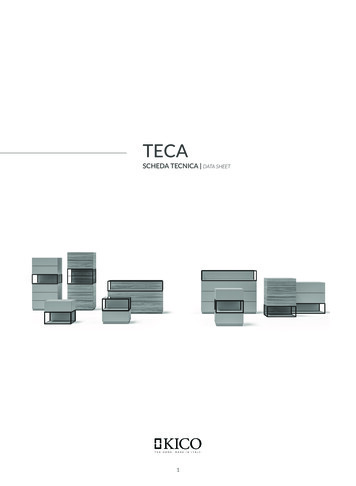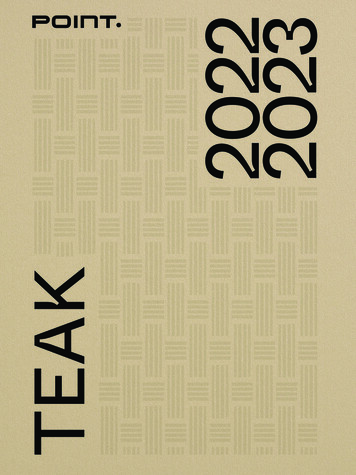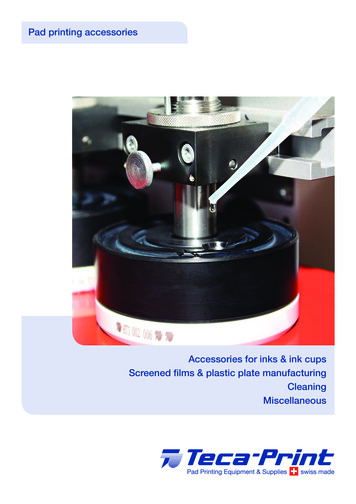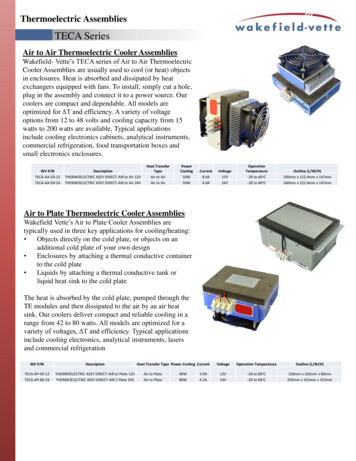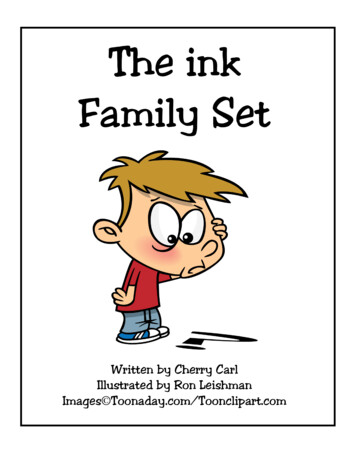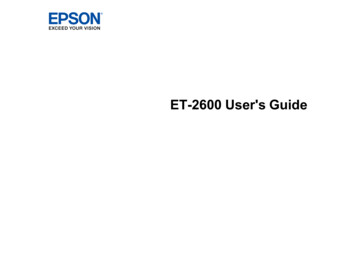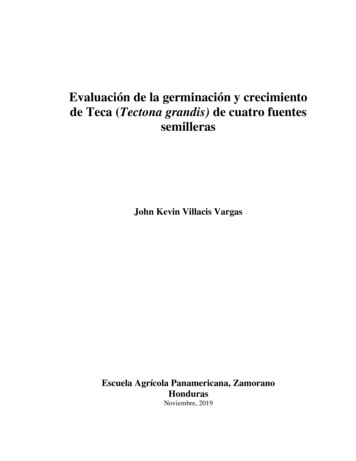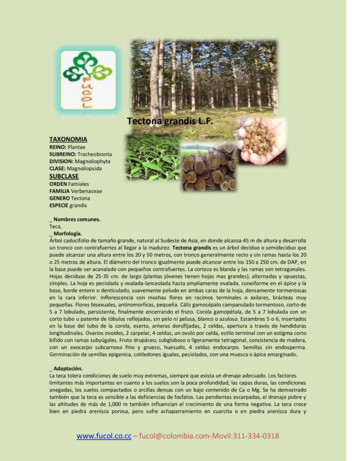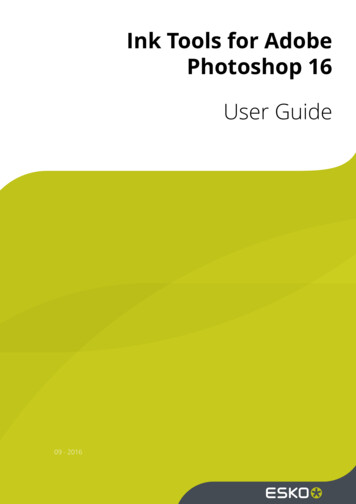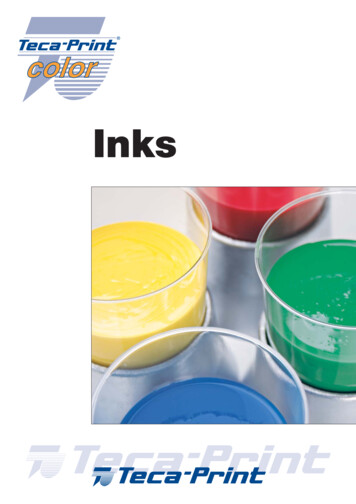
Transcription
Inks
INK USE INFORMATIONTHE PAD PRINTING PROCESSThe basic principle of the pad printing process is that the ink becomes tackydue to evaporation, first in the cliché before ink pick-up and then on thepad. This effect is used to transfer the ink from the cliché to the pad and thenfrom the pad to the workpiece.1. Pre-treatment of polyolefinesTo obtain an optimum ink adhesion on polyolefine, polyethylen (PE) and polypropylen (PP), materials must be pre-treated. The surface tension mustbe at least 38 Dyn 0.038 N / m. The surface tension can be tested usingthe test pen (see accessories list on our website), which is filled with ink adjusted to exactly this value. If the surface tension is below 0.038 N / m,more intense pre-treatment is needed. The possibilities for pre-treatmentare flaming, corona or primer / adhesion promoter MT.2. Post-treatment of polyoxidesAnother group of materials that require extra measures for good ink adhesion are polyoxides, e.g. acetyl resin, delrin, Hostaform C etc. After the printthe materials must be subjected to a thermal shock to achieve a chemicalreaction of the ink with the material surface. The thermal shock should beapprox. 350 C and can be generated with a flaming or thermodiffusion(hot-air) unit.3. Curing time2-component inks usually require 2 – 6 days for chemical curing. After thistime, an optimum adhesion, chemical resistance and abrasion resistanceare achieved. However, with that in mind, further work with the printed parts(e.g. packaging or part assembly) is possible once the part is dry to thetouch, as long as the image is not altered by a sharp or rough surface. See“ink and hardener properties” chart.4. Chemical resistance1-component inks never achieve the same chemical resistance as 2-component inks. 1-component inks are mainly used on materials which are easily etched by the mixed ink. In this case the substrate has no betterchemical properties resistance than the printed 1-component ink itself.6. The viscosity processAll inks must be adjusted to the correct viscosity. With 2-component inks,it is critical that ink and hardener are thoroughly mixed prior to adding thinner. If this is not observed, lumps of concentrated hardener remain resultingin partial curing of the ink, which has an adverse effect on the subsequentink transfer and adhesion. The desired working viscosity is achieved throughthe addition of thinner in small amounts while constantly stirring. If thinner isadded all at once or in large quantities, the ink pigments are washed out ofthe resin. This is called ink pigment shock and the ink will be flaky and unusable. During printing, thinner evaporates and the ink thickens. Therefore,thinner must be replaced in regular intervals; once again in small quantities.As for the open ink well system, the thinner is mixed with the ink using a spatula after the doctor blade has been removed. Ink viscosity adjustment depends on the ink colour tone. Certain pigments cause thixotropic reactions.Both thixotropic and high-density inks can not be tested with the Viscospatula. If you reach good printing results with a particular ink, put some ofit into a mixing cup, stir it well, and test the viscosity. Keep note of your testresults for when you next use the same ink again.7. Use of retardersUsually, ink viscosity should be only adjusted using thinner. If there are exceptional environmental influences, such as high room temperatures, drafts,prolonged cycle times among other things, retarder can be added in controlled quantities. We recommend to produce a quantity of your own custom retarder out of thinner and retarder, for example mixed 4:1, and use itto adjust ink viscosity.8. Flow agentFlow agent is used to reduce the ink’s surface tension. Flow agent containssilicone and therefore only small quantities should be added, approx. 1 drop /10 g ink. Remember that flow agent reduces ink adhesion!9. Pot life2-component ink systems cause a chemical reaction. Pot life is reducedby high room temperatures and a high relative air humidity (RAH).5. Abrasion resistanceWhen high abrasion resistance is required, 2-component inks should beused.MIXING SYSTEMS, RECIPES AND INK RANGEMixing SystemsFor all ink ranges, mixing systems are available.RecipesWe have recipes for over 1000 colour shades available free of charge. Allcolour recipes are based on printing made on white backgrounds.Data can be ordered for HKS, RAL and PMS. Please ask for our recipe catalogue (or download the pdf from www.teca-print.com).For printing onto dark substrates, transparent objects and mirror areas,special shade recipes need to be formulated. For this we require the exactcolour reference of the desired ink tone (PMS, HKS, RAL or a sample) andthe colour shade of the substrate (preferably a sample).Ink range (HD extra opaque inks)All ink types are available only in NT pigmentations and conform to EN 71,part 3, safety of toys, migration of certain elements.
1 COMPONENT INKSTPC 118PropertiesHighly opaque silk gloss pad printing ink for theprinting of various kinds of plastic materialslike hard and soft PVC, coated polyester and PET-G, polystyrene and its modifications such as ABS, ASA,SAN,acrylic glass PMMA and polycarbonate PC, pretreatedpolyolefine PP and PE, manifold coated surfaces and layers as well as cellulose acetate CA and CAB, papers andcardboard products.very highly opaque, excellent fluidity, may be applied foropen and closed machine system, quick drying.TPC 200PropertiesTPC 2301/2 COMPONENT INKSTPC 180PropertiesTPC 301PropertiesTPC 320PropertiesTPC 528PropertiesMost universal pad printing ink, opaquesuitable for thermoplastic materials as well as duroplastics, wood, paper and metals.excellent opacity (HD version). User-friendly and quickdrying processing in open and sealed ink well systemsand for rotary printing. Glossy finish.a printing ink free from cyclohexanone and aromatic compounds, for universal use on a wide range ofsubstratesespecially suitable on polystyrene PS and its modificationssuch as ABS, ASA, SAN, on PC, PBTP, CA, CAB,PMMA, PVC rigid, on 1-k- and in some cases on UV-laquers, wood and paper.Weatherproof, glossy, fast and flexible drying pad printingink with a excellent printability. Especially suitable for printing on toys and the outside of food packaging.Universal, stable pad printing ink, very glossysuitable for thermoplastic materials, especially ABS, PSand its co-polymerisates ABS, ASA, SAN, hard PVC,PMMA and polycarbonate PC. On polyester, polyamidePA and other duroplasts pre-treatment may be necessary.Very user-friendly. Weather-, petrol- and alcohol-resistant,this can even be improved by adding hardener. Glossy finish.Highly opaque, silk gloss pad printing ink for theprinting of various kinds of soft and hard plasticmaterials and metals.suitable for various kinds of plastic materials such as hardand soft PVC, coated polyester and PET-G, polyamideand polyetherimide, polystyrol PS and its modificationssuch as ABS, ASA, SAN, etc. acrylic glass PMMA andpolycarbonate PC, pretreated polyolefine PE / PP, tyvek,manifold coated surfaces and layers as well as celluloseacetate CA and CAB, papers and cardboards like variousmetals, aluminium, compound materials such as alucobond, dibond and vekaplan AL.excellent fluidity, may be applied for open and closed machine system, quick drying.2 COMPONENT INKSTPC 508PropertiesHighly opaque, silk gloss pad printing ink for theprinting of various kinds of soft and hard plasticmaterials and metals.suitable for various kinds of plastic materials such as hardPVC, PET modifications (-A,-E,-P), polyamide PA and polyetherimide PEI, polystyrol PS and ABS, SAN, etc.,acrylic glass (PMMA) and polycarbonate PC, pretreatedpolyolefine PE/PP, tyvek, manifold coated surfaces andlayers as well as cellulose acetate CA and CAB, papersand cardboards, multi-coated surfaces and coatings, metals, aluminium and aluminium composites, such as alucobond, dibond and vekaplan AL, wood and polyacetate(POM) with follow-up flaming, glass.excellent fluidity, may be applied for open and closed machine system.PropertiesTPC 250PropertiesTPC 270PropertiesHighly resistant, glossy pad printing inkUsed in the technical industries and graphic fields for cellulose acetate CA, polyamide PA, polyester, acetyl resins(post-treated) POM, pre-treated polypropylene PP, thermoplastics, metals and varnished substrates (also forpowder coated and 2 component painted surfaces).Quick drying ink system with good adhesion, glossy finish.Good opacity (excellent in HD version).Pad printing ink with maximum resistanceBest adhesion characteristics with thermoplastics, varnished surfaces, metals, NE-metals, polyamide PA, polycarbonate PC, polyester, polymethacrylate PMMA,polyurethane PUR and hard PVC. Used for industrial andadvertising applications.Quick drying and glossy. High chemical resistance againstorganic solvent, chemicals, thinned alkalis and acids. Theresistance against mechanical abrasion is substantiallybetter compared to TPC 200. Good opacity (excellent inHD)Glossy pad printing ink for glass and bottle printingExcellent ink for use on thermosets including, ceramics,metals; including chromed, nickel, gilded or rhodanisedsurfaces.When mixed with HG, HH or HI hardeners, a perfect adhesion is achieved with curing or air drying depending onthe harder used. Very high chemical and mechanical resistance. High colour brilliance.high resistence, sterilizable pad printing ink, glossysuitable for duroplastics, epoxy resins. Lacquerd bottles,diverse metals and thermoplastics.Suitable for medical sterilizaion up to 140 C / 1 hour,quick drying, glossy. Highly chemical and weather resistent. Very highly opaque (HD).UV CURING INKSTPC 728PropertiesTPC 760Propertieshigh gloss UV-curing pad printing ink for decoratinga vast array of plasticspre-treated polyolefins PP / PE, rigid-PVC, polystyrenePS and its derivates such as; ABS, SAN, etc., PMMA,polycarbonate PC, polyamide PA (also glass-filled), andpartly PET-materials, as well as duroplastic. Also suitablefor various coated surfaces and works on some metals.fast curing and extremely high resistance, similar or betterthan 2-component solvent based inks.UV-curing pad printing ink for printing onto pre-treated polypropylenesuitable for PVC, PC, PET, styrene and its copolymers PS,SB, ABS, SAN and ASA.The TPC 760 ink cures to a hard, rough ink layer, and issuitable for printing on hard material substrates only.
good, very good, excellent( ) suitable: for increased requirements for chemical resistance, or weatherproof, drying or other special ink characteristics, tests should be conducted.1 pre-treatedFG with fiber glass* oven curedpart. partiallyADHESION PROPERTIESPLEASE READ THE TECHNICAL DATA SHEETS ON PAD PRINTING INKS AND ADDITIVESPlease note: This information is accurate to the best of ourknowledge however is furnished without expressed or implied warranty. Our statements are based on topical technical knowledge and ex-perience. Due to the variety of possible influences during use, tests underlocal conditions are necessary. We reserve the right to make technicalchanges without prior notice.
USING THE VISCOSPATULAInstructions:1. Stir the ink to ensure thorough mixing of the pigments.2. Place the Teca-Print mixing cup in the Teca-Print cup holder.3. Pour the required amount of ink into a mixing cup.4. Add thinner drop by drop whilst constantly stirring.5. Dip the VISCOSPATULA into the cup so that half of the large / top holein the VISCOSPATULA is immersed in ink.6. Lift the VISCOSPATULA vertically out of the ink.7. As the ink flows down the VISCOSPATULA, watch how the holes openup from top to bottom. The amount of time it takes for the ink to flowfrom the first small hole to the bottom (fifth) small hole ( measuring distance “L” on chart) indicates the viscosity (velocity of flow) of the ink.Measure the flow time with a wrist watch. Experience indicates that atime of about 8 seconds is advisable although this can vary slightly depending on ink type, colour and particular ink usage.Hints:If the flow time is too quick, then the ink is too thin,the addition of unthinned ink will thicken it up. If the flowtime is longer, thinner should be added in small quantities at a time whilst stirring.If the ink behaves thixotropically (e.g. some ink toneswith blue) the VISCOSPATULA is not reasonably applicable. Such ink tones are usually adjustable with 8 –10 % solvent addition.INK AND ADDITIVE ORDERING INFORMATIONInksOur extensive range of inks is supplied in 1 l cans. Most inks are alsoavailable in practical 200 ml tubes. Fluorescent tones (TPC 180) areonly available in 1 l cans. Delivery time: about 4 weeks. The inks typesTPC 118, 508 and 528 are available in 500 gr cans. Delivery time: about1 week. Metall colour inks are only available on demand.***L measuringdistanceAdditivesHardener is available in 100 ml tubes and 1 l cans. All solvents andspecial additives are supplied in 1 l cans, some are also available in 5 lcans or 25 l barrels. Please refer to the table below for order numbers.upon request, about 2 – 4 weeks delivery timeis not to be added to the inkAS antistatic agentAP antistatic paste PV retarder paste MP matt powderMT bonding additive MV flow agentPP adhesion promoterxx: to order, please use the following number format:standard ink tone:F32 31800 2F32 TPC 320, 31 Blue 31-NT, 00 Standard ink tone, 2 200 ml tubeGF mixing system:F18 92805 4F18 TPC 180, 92 GF-mixing system, 05 GF-mixing system ink GF-05 (magenta), 4 1 l canMG mixing system: F30 92809 4F30 TPC 301, 96 MF-mixing system, 09 MF-mixing system ink MF-11 (green), 4 1 l canspecial ink orders:F20 00107 4F20 TPC 200, special shade Nr. 00107-NT , 4 1 l can
USE OF ADDITIVESglass inkoven curedfor cleaning all accessories(1)(2)(3)(4)(5)(6)Hardener must be used in an appropriate ratio to the ink. Strongdeviations from the noted ratios above can lead to problems. Someproblems may take a while to show and can eventually affect resistance and adhesion. Thus, after adding hardener and thenthinner – this order is very important – the mixture should restfor approx. 15 minutes so that optimum ink flow and adhesionare achieved.Hardener only to increase the chemical resistance.Pot life can be reduced by approx. half for metal colour tones. Withsome ink types, pot life depends on a direct relationship to roomtemperature (RT) and relative air humidity (RAH).Evaporation rate: the lower the value, the faster the evaporation,f relative evaporation rate compared to VC and VD.Thinner VP increases ink adhesion onto polystyrol and related materials.Extremely mild thinner to protect PMMA and polystyrene (moldedpieces) from stress or tension cracks. The thinner VX does not etchinto the surface and as a result can also be used as a cleaner.(7)(8)(9)(10)(11)***Thinner VR contains XYLOL and cannot be classified as non-hazardous like the other solvents. The flash point is 0 , extra careis to be taken due to flammability!Adhesion promoter MT is not to be added to the ink. Pre-treatment e.g. via wiping objects with an MT-soaked cloth, spraying ordippingthem.Bonding additive MD is a printable “in line” variation of the MTbonding additive and is applied as a single hit prior to the ink application.Bonding additive MT should be added in 10 – 20 % quantities. Itdoes not alter pot life, but does reduce resistance values.General additives can be used for all ink types except for ovencured inks, UV inks and TPC 301.Retarder agents are used for more specialized applications inwhich a defined thinner-retarder ratio is used.requires UV-Light exposure (mJ / cm2) in order to fully cure the ink.free of cyclohexanone and condimentsx suitableYou will find more information about the ink andhardener properties (opacity, drying.), summedup in a user friendly chart on our website.706 100 092-E /02.09PLEASE READ THE TECHNICAL DATA SHEETS ON PAD PRIN TING INKS AND ADDITIVES
1. Pre-treatment of polyolefines To obtain an optimum ink adhesion on polyolefine, polyethylen (PE) and po-lypropylen (PP), materials must be pre-treated. The surface tension must be at least 38 Dyn 0.038 N / m. The surface tension can be tested using the test pen (see accessories list on our website), which is filled with ink ad-
